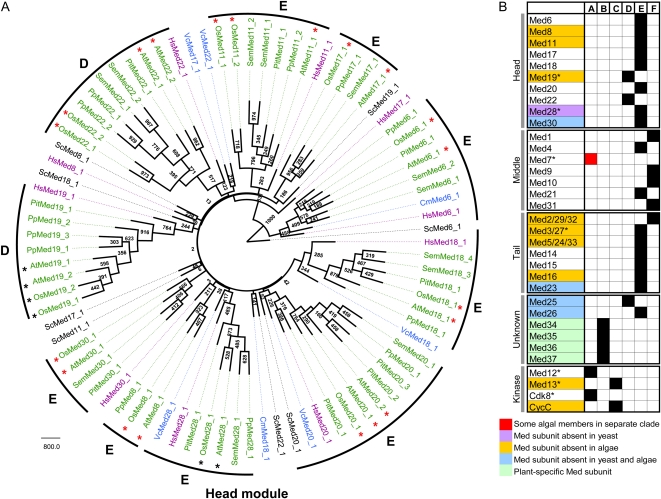Figure 3.
Phylogenetic relationship of Med subunits among various members of the yeast, metazoan, and plant kingdoms. Med proteins from one representative member of the seven plant groups, human (Hs), and S. cerevisiae (Sc) were assigned into the different modules of the Med complex. A, An unrooted tree of the head module constructed using the PHYLIP program by the neighbor-joining method. Numbers at the nodes represent bootstrap values from 1,000 replicates. A bootstrap value of at least 500 was used to define the Med subunits into groups A to G (see B). All the terrestrial plants (angiosperms, gymnosperms, pteridophytes, and bryophytes) are shown in green, algal members in blue, and Hs and Sc sequences in purple and black, respectively. Angiosperm-specific clades are marked by black asterisks and mixed clades by red asterisks. The scale bar represents amino acid substitutions per site. For the phylogenetic trees of the middle, tail, unknown, and kinase modules, see Supplemental Figures S1 and S2. B, Summary of the phylogenetic grouping of plants with Sc and Hs Med subunits. Groups A and B represent a single clade of all the putative Med proteins in terrestrial plants and algal members (black boxes) or at least one member of the algal group (red boxes) at 500 or greater bootstrap value. Groups C to E represent only the terrestrial plant members (either the algal members have not been predicted or do not group together with the land plants). Groups A and C include both the Sc and Hs members, while group D has only Hs members in the same clade as the plants. In groups B and E, the Sc and Hs members do not group together with plants. When the land plants did not group together to form a single clade, they were assigned to group F. Med subunits having angiosperm-specific clades are marked by asterisks.

